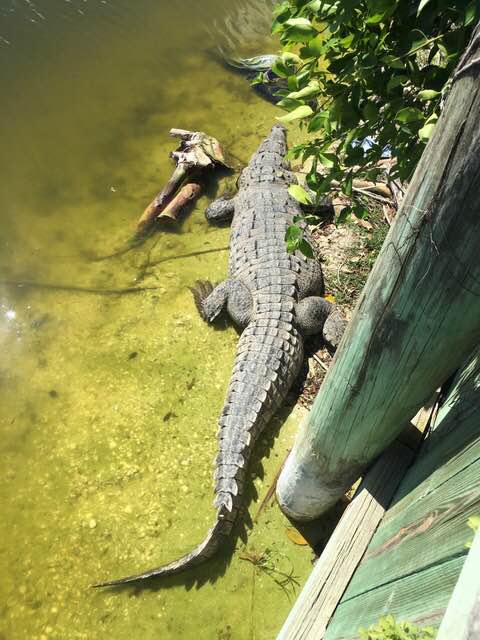In rare photo, crocodile suns itself with alligator at Florida golf course
FORT MYERS, Fla. – Florida golfers know alligators all too well, but they don't often encounter rare American crocodiles.
That's changing on a local barrier island, where an adult croc has recently been photographed sunning itself alongside alligators at the Sanibel Island Golf Club.
"The crocodile is here all the time, she hangs out on hole No. 11, and she’s a female," said Mary Donnelly, wife of course owner Drew Donnelly. "Don't ask me how they know it's a female. And the maintenance guys call her Fred."
Related Video: You Can Dive With 14-Foot Crocodiles
Crocodiles have been documented on Sanibel before, and a few have even been found in the Cape Coral area.
Their ranges overlaps in extreme southern Florida, along the coasts and in Florida Bay.
Seeing one is unique, but capturing both species in one photo is akin to winning a scratch-off lottery.

"I hadn’t seen it until that picture, but I know a guy who walked up and the croc was laying there with its head on the alligator’s tail," Drew Donnelly added. "But he didn’t get a picture."
What's the difference?: How to tell the difference between a crocodile and an alligator
University of Florida researcher and crocodile expert Frank Mazzotti said a few crocodiles have made it as far north as Tampa.
Nests have been documented on Sanibel, but none of the eggs hatched.
"Before that horrible freeze in 2010 we had a crocodile that spent much of its time in the (J.N. "Ding" Darling National Wildlife) Refuge and it used to nest in people's yards," Mazzotti said. "That animal nested over a number of years but there was never any evidence that the eggs were fertile."
Mazzotti said there are fewer than 2,000 American crocodiles, which is up from a population that only had 20 recorded nests per year during the 1970s.
More: Rare American crocodiles living on Sanibel
Today, there are more than 150 nests in an average year, he said.
Mazzotti said both American alligators and crocodiles are relatively docile among the crocodilian world, which includes the 20-foot varieties found in Africa and Australia.
"Alligators are a wee bit more aggressive," Mazzotti admitted. "You can tell that when you catch them. Alligators put up a little more of a struggle than crocodiles."
Who wins in a fight?
"An old newspaper article written in the 1920s described a bunch of Everglades City boys with a big alligator and some Key Largo boys that had a big croc," Mazzotti said. "And the story is they pitted them against each other and the alligator ended up winning because it had a larger jaw."
Follow Chad Gillis on Twitter: @ChadGillisNP
Just the facts
American crocodile (Crocodylus acutus)
►Found in South Florida, Mexico, Central and South America and the Caribbean.
►Nesting occurs on well-drained, sandy areas near salt or brackish water. Females begin building nests in March and typically lay about 40 eggs in late April or early May. They return in July or August to dig up the nest and sometimes transport the hatchlings to the water.
►Like alligators, crocodiles control their body temperature by basking in the sun or moving to a cool, shaded area. Crocodiles sometimes lay with their mouths open, which is not a sign of aggression.

►Will eat almost anything that moves. Hatchlings and young crocodiles feed on small fish, snails and insects while adults eat fish, crabs, turtles, snakes and small mammals.
►Listed as an endangered species by the U.S. Fish and Wildlife Service in 1975.
►State and federal laws prohibits killing, harassing and possessing crocodiles.
Sources: Florida Fish and Wildlife Conservation Commission, University of Florida, U.S. Fish and Wildlife Service
This article originally appeared on Fort Myers News-Press: In rare photo, crocodile suns itself with alligator at Florida golf course
Start the day smarter:Get USA TODAY's Daily Briefing in your inbox

